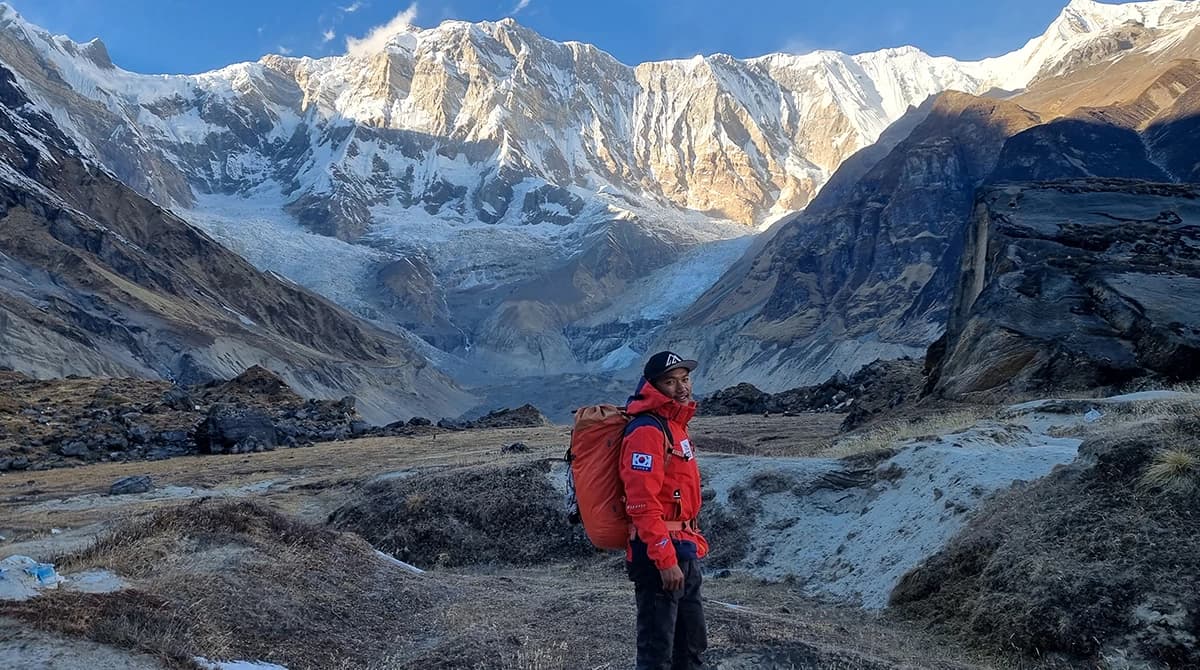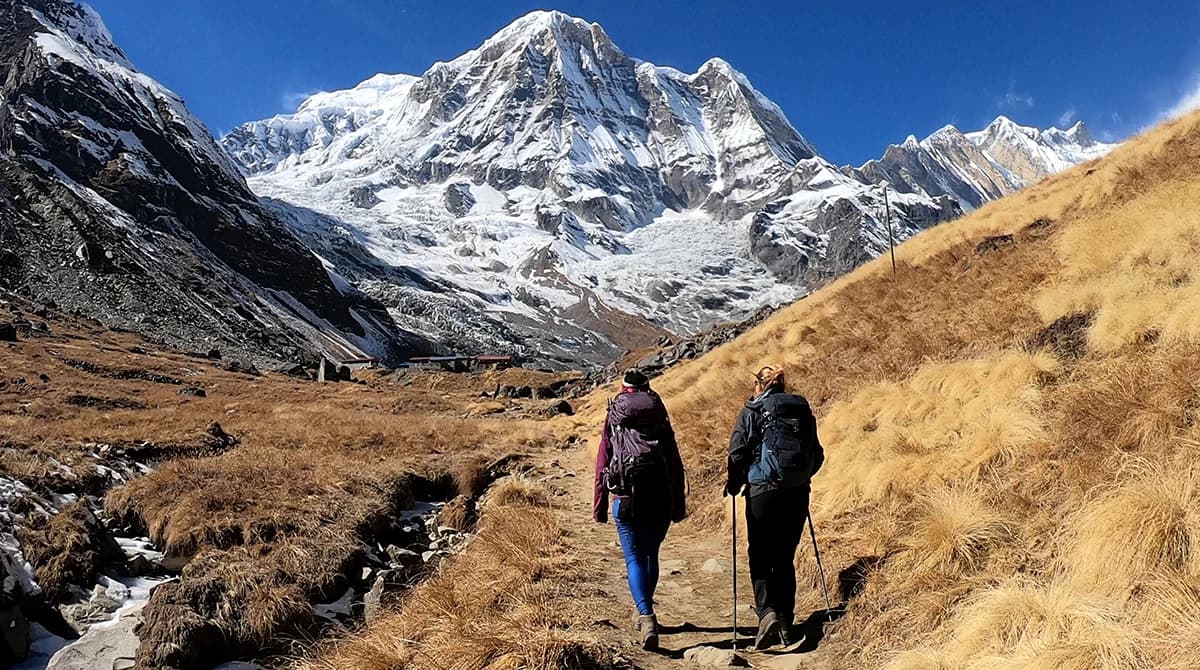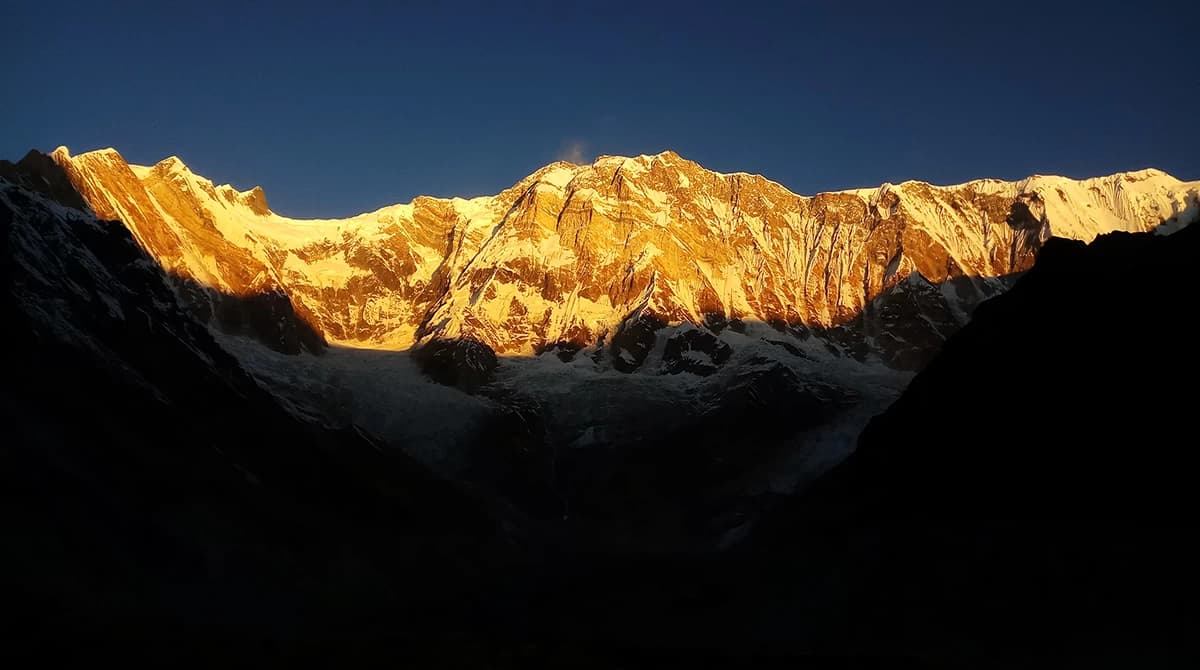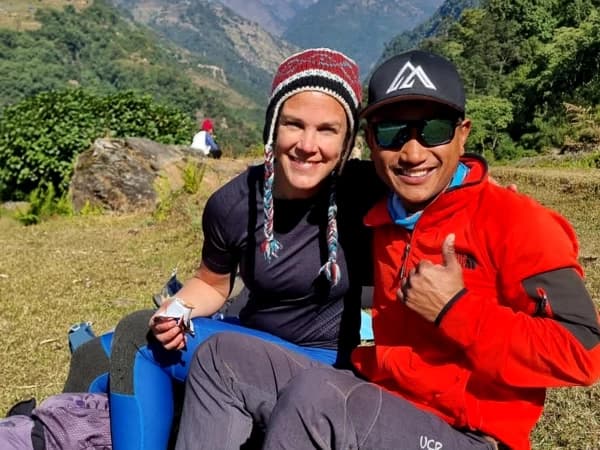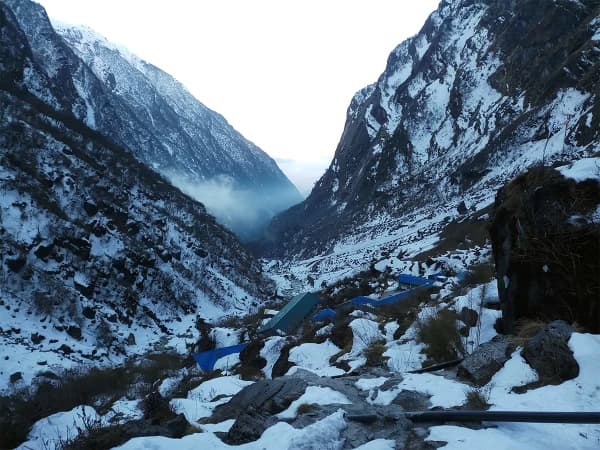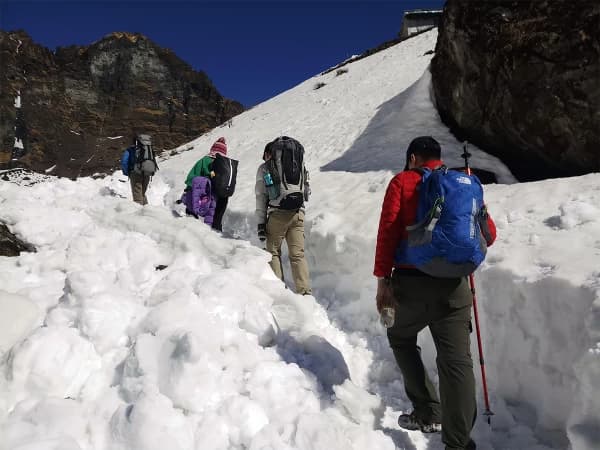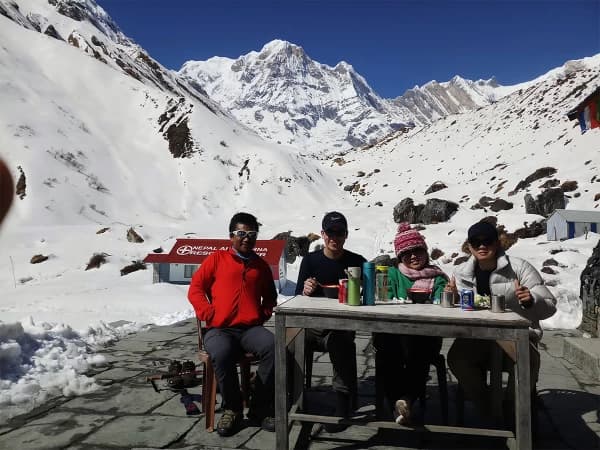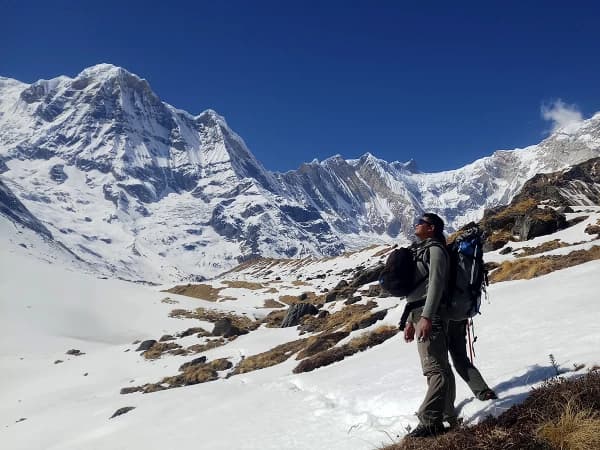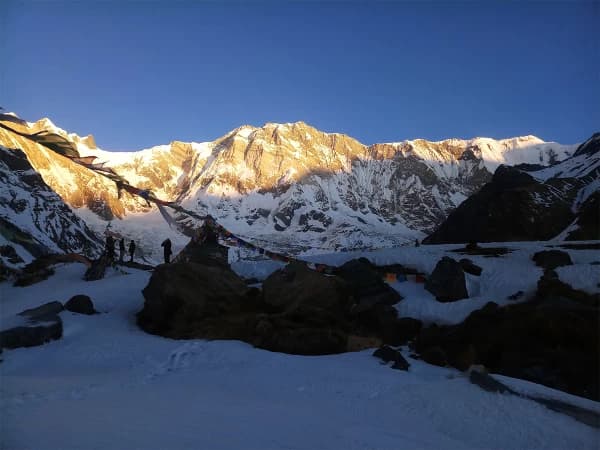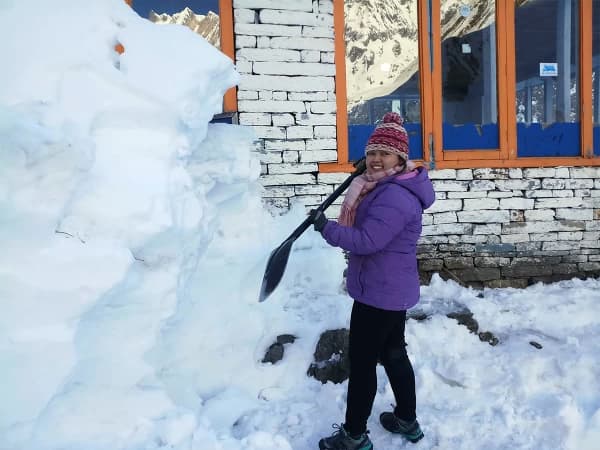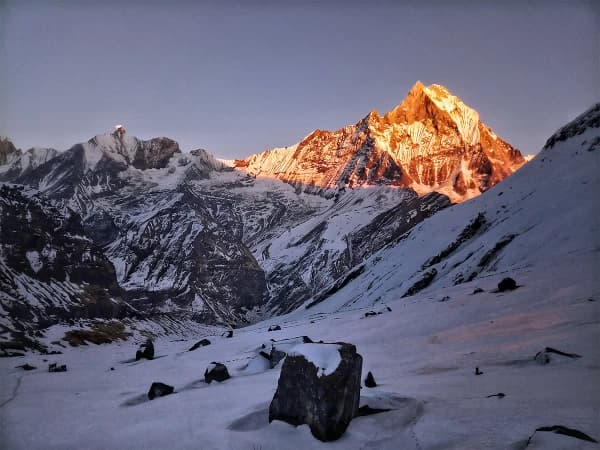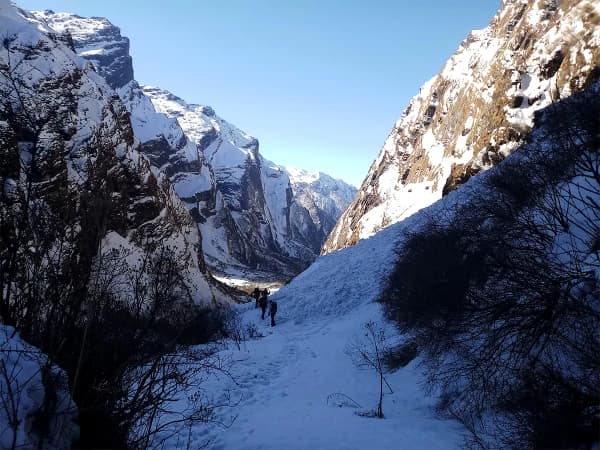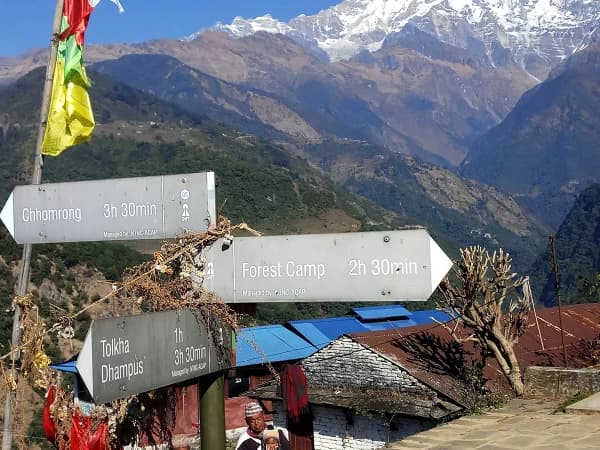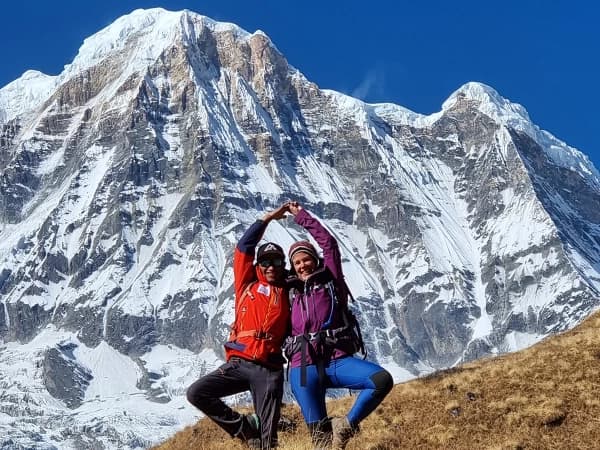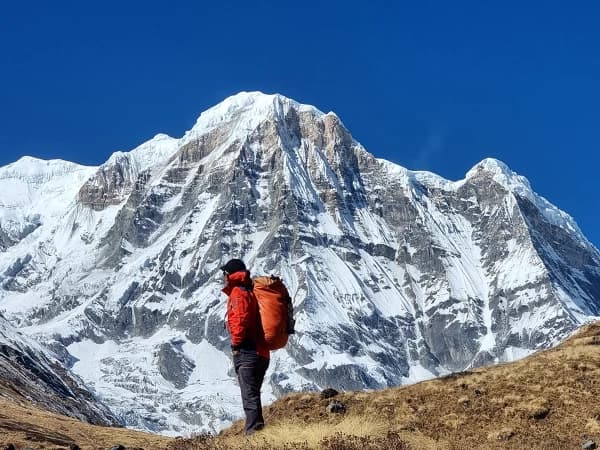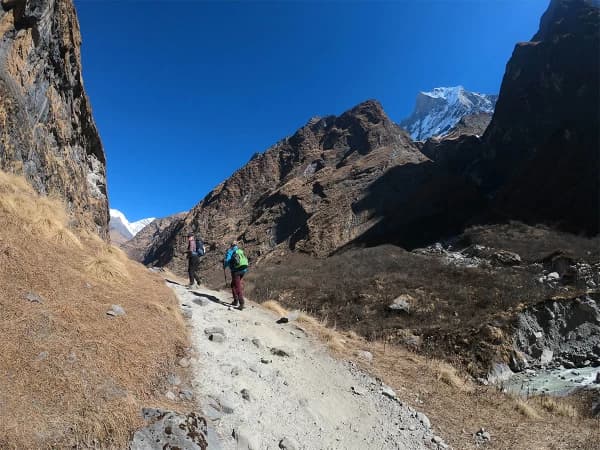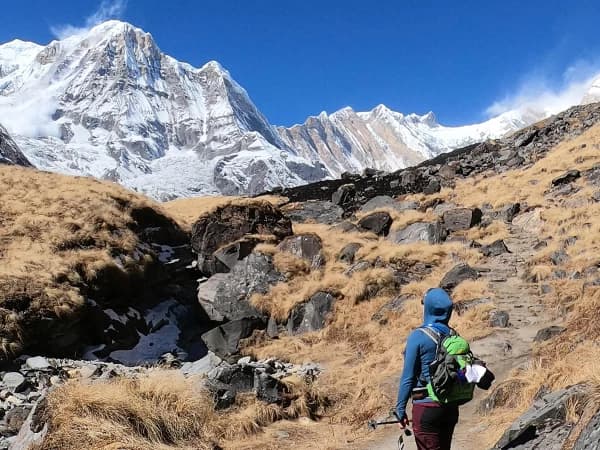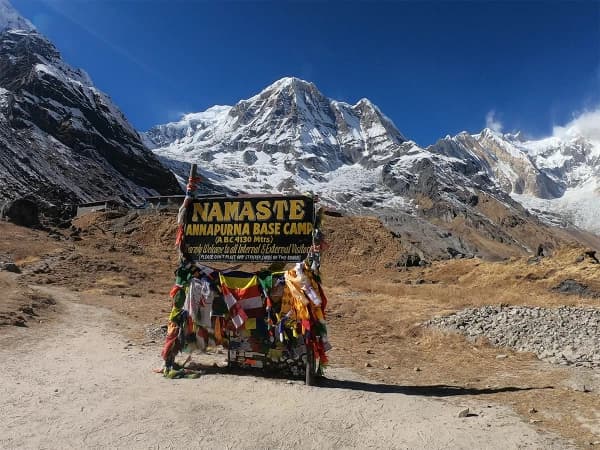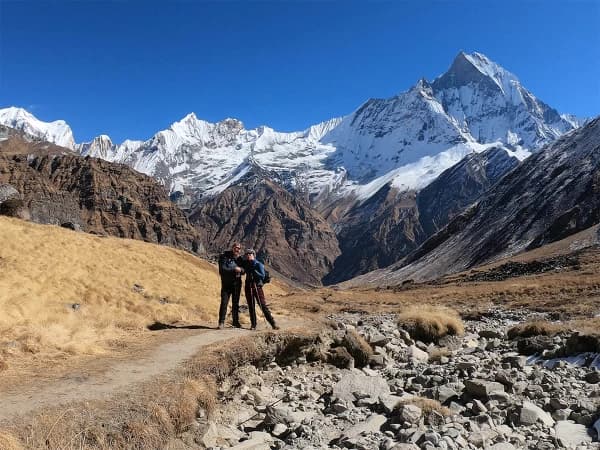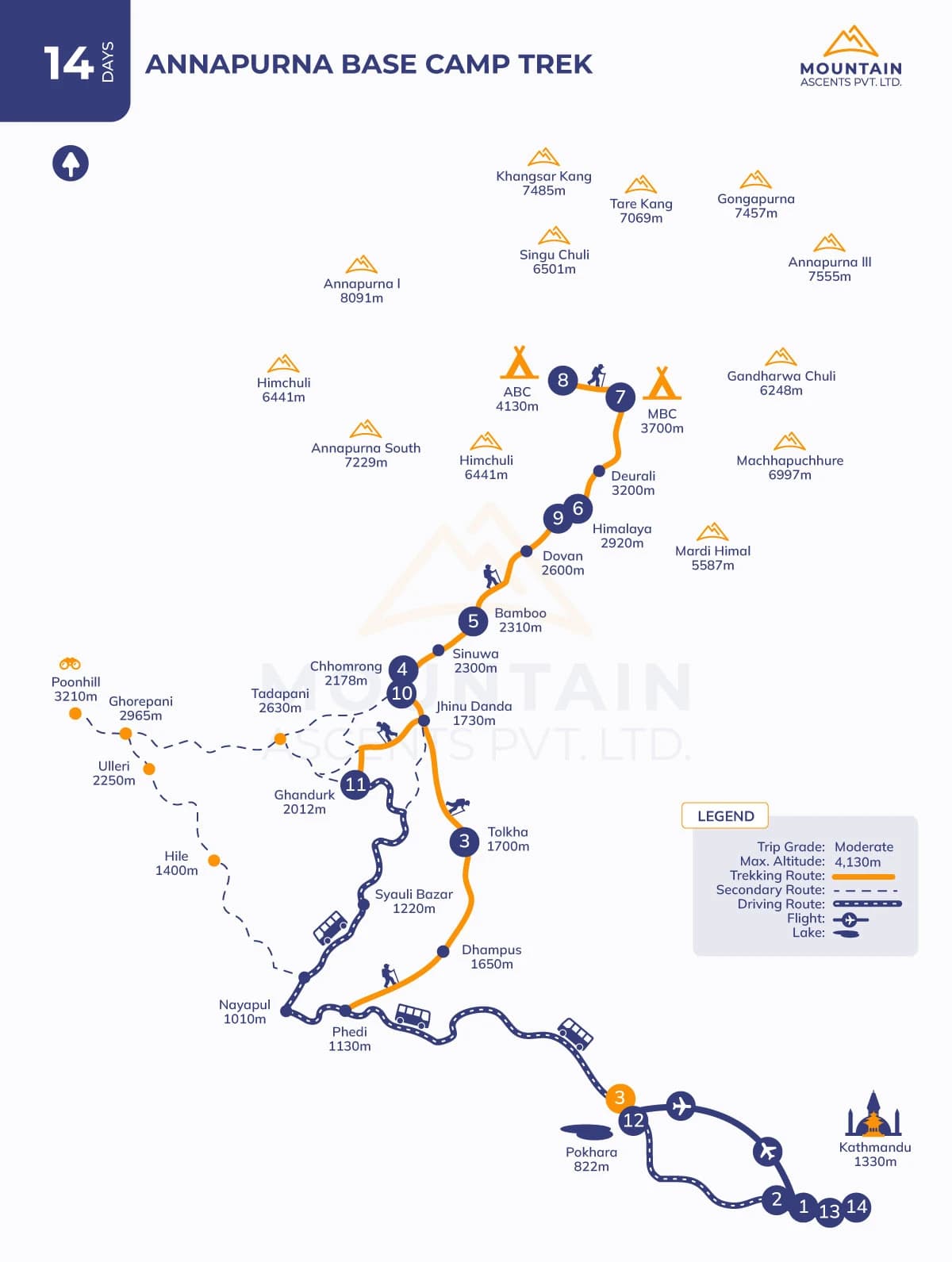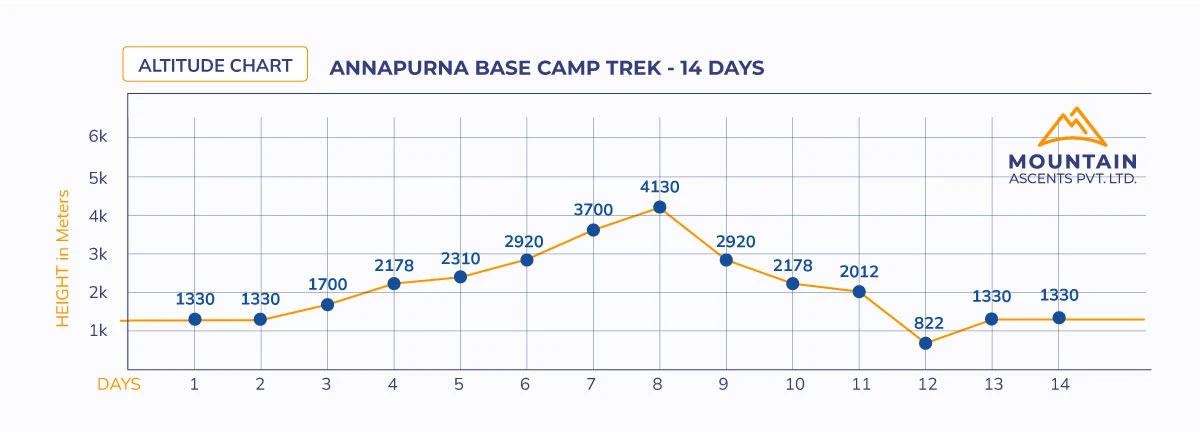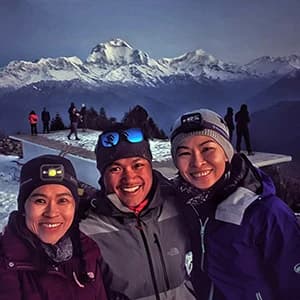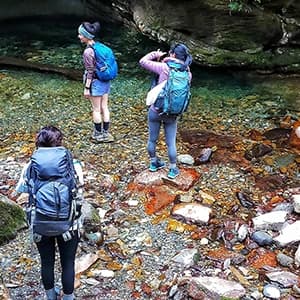The Annapurna Base Camp (ABC) Trek in the heart of the Annapurna region in the central west region of Nepal, often referred to as the Annapurna Sanctuary, is one of the most popular trekking routes. Famous for the unique blend of natural beauty and cultural richness, offering a once-in-a-lifetime opportunity to explore picturesque villages, lush green forests, and changing landscapes, this Himalayan Odyssey is easy to access in comparison to Everest Base Camp (EBC). Like a beautiful folktale, the journey to reach the Annapurna Base Camp at an altitude of 4,130 m/13,550 ft unfolds the mysterious beauty of the Annapurna region, predominated by the Annapurna Massif, the tenth highest mountain range in the world, 8,091 m one after another. As you move closer and closer to the magnificent mountain giant, passing through scenic terraced farms and typical mountain villages of Gurung and Magar, you will get to witness the surrounding peaks in all their glory.
Usually, this classic Annapurna Base Camp Trek route begins with a soul-stirring flight from Kathmandu to Pokhara and drives along the stunning hills, traditional villages, and roaring rivers to reach Phedi as the trek starting point. From Phedi, the path winds past terraced fields covered with colorful rhododendron flowers, providing an insight into the local way of life. As you climb, the scenery gets more spectacular, and the air gets crisper; you'll get panoramic vistas of snow-capped peaks that reach up to the sky. Each step is filled with the spirit of the mountains and is more than physical adventure as you get to spend nights in the local tea houses and lodges, providing an insight into the way of life in the Himalayas: simple yet full of culture, traditions, and customs, fostering deeper connection among living communities and nature. For starters, Annapurna Base Camp Trek is just the perfect destination, promising a balanced adventure best done in the months of spring and autumn.
Therefore, get ready now for a fantastic Himalayan Odyssey that stands second to none, the Annapurna Base Camp Trek, and reach heaven-like landscapes at the base of majestic mountains, rewarding you with the breathtaking, other-worldly views of mountains like Machhapuchhare, Annapurna South, Annapurna I, Annapurna III, and Gandharva Chuli, along with other Himalayan summits! Trek with Mountain Ascent for a safe and exciting adventure. We make your dream come true!
Trip Highlights
- Guided UNESCO World Heritage Site Sightseeing in the Kathmandu Valley of Nepal, including Pashupatinath Temple, Swyambhunath, Boudhnath, and others.
- Step into the center of the majestic Himalayas of Nepal, Annapurna Conservation Area.
- Catch a thrilling flight from Kathmandu to Pokhara and vice versa.
- An opportunity to encounter exotic Himalayan flora and fauna, including rare snow leopard, red panda, Himalayan tahr, Musk Deer, Langur Monkeys, Himalayan Black Bear, Blue Sheep, Pheasants, and many more.
- Get to experience the first-hand hospitality of the Himalayan locals as you stay in local teahouses passing through quaint yet scenically rich Magar and Gurung villages.
- Panoramic views of the two highest mountains in the world, Mt. Annapurna (8,091 m/the tenth tallest mountain range in the world) and Mt. Dhaulagiri (8,167 m/the seventh highest peak on the earth), and surrounding peaks including Machhapuchhare, Nilgiri, Tukuche, Gangapurna, and others.
- Make it to not only one but two base camps in the Annapurna region of Nepal: Annapurna Base Camp and Machhapuchhre Base Camp in the ultimate serenity with outstanding 360-degree views of the surroundings, etc.
What can you expect during the Annapurna Base Camp Trek?
The Annapurna Base Camp Trekking offers a blend of majestic landscapes, highland culture, diverse climates, and moderate trekking challenges under the conservation area guarded by the towering Annapurna ranges, also known as the Annapurna Sanctuary. The sanctuary features a seamless fusion of dramatic Himalayan scenery, a flourishing ecosystem, Gurung villages, terraced farms, and thick forests, priming a serene escape from hassling city life.
Once the trekking days begin, expect to walk 5-7 hours each day with more refined Himalayan vistas as you move closer and closer to the Annapurna Base Camp (ABC). Some sections are rugged and composed of steep ascents and descents, especially at high altitudes. However, manageable trekking conditions promise you a once-in-a-lifetime journey perfect for nature lovers and adventure seekers, added much by:
Close-up mountain views
Right from Pokhara, also taken as the gateway to the Annapurna Trekking region of Nepal, trekkers, visitors, and travelers alike can relish the dynasty views of several Himalayan peaks. As you make your way through the various climatic zones and vegetation, you will be able to grasp the unique perspective of Himalayan giants like Mt. Dhaulagiri, Mt. Machhapuchare, Mt. Nilgiri, Mt. Gangapurna, Mt. Hiunchuli, Tukcuche Peak, and others.
In the lower altitude, dotted with subtropical forests, terraced meadows, and typical villages of Gurungs and Magars, these Annapurna Himalayas tease you with occasional glimpses as you move back and forth through the lush hills and dense forests of oak, pine, and rhododendron. Once you reach higher altitudes above 3,000 m, the snow-clad peaks appear just above the head, adding much to the serenity of alpine meadows and glacial moraines with only sparse human settlements, particularly around the Machhapuchhre and Annapurna Base Camp.
Take a moment to appreciate the natural amphitheater, offering unparalleled vistas and fills you with an unmatchable sense of achievement and adventure like never before, making the Annapurna Base Camp Trek worth an effort.
Easy accessibility to the diverse Himalayan landscape
The Annapurna Base Camp Trek is easily accessible from Pokhara, a lovely lakeside city of Nepal, and takes you through the Annapurna Conservation Area (ACA), the largest protected area covering 7,629 sq km, established in the year 1986. The wild Himalayan land is home to over 1,200 flora, 100 mammals, and 450 bird species. On a lucky day, you can even get to witness fauna like Himalayan thar, deer, and snow leopards, as well as several species of butterflies.
Within just a few days, the journey to reach the Annapurna Base Camp transits from subtropical lowlands with terraced rice, barley, and potato fields to dense forests of rhododendron, bamboo groves, and oak and high-altitude landscapes into the center of the Annapurna Sanctuary. The trek showcases stunning contrasts in a short amount of time, reducing travel time without the need for extensive technical skills.
The trekking experience is epic jaunting through the well-maintained trails, where every step unveils the unique beauty of the Annapurna region. Look forward to being part of the symphony of shimmering rivers and waterfalls with the chirping of birds and the crossing of high suspension bridges, providing a new taste of adventure.
A must to seize the opportunity to immerse into the local culture.
During your journey to the Annapurna Base Camp Trek, trekkers pass through several traditional villages like Chomrong, Bamboo, Landruk, and Ghandruk inhabited by indigenous people of Gurung and Magar. Known for their friendly nature, young lads in Gurkha, and warm hospitality, it will be an amazing experience to taste the local cuisines and witness their unique cultural practices, songs, dances, cultural attire, and way of life.
Most of the tea houses en route to the trekking trail leading towards Base Camp are also run and managed by these Himalayan locals, happy to share meals usually consisting of traditional dishes like dal bhat and momos, the story of the Himalayas, resilience, and customary way of life, deepening the connection and understanding of their daily lives and traditions.
These cultural factors are also what make the journey to the Annapurna Himalayas more than about gigantic peaks adding depth to the Annapurna Base Camp Trek that you would definitely want to return for!
Exploration of less crowded, sacred, and mythical Himalayas
In comparison to the Everest Base Camp (EBC) Trek in the Everest/Khumbu region of Nepal that reaches the foothold of the top of the world, Mt. Everest (8,848 m), the Annapurna Base Camp Trek is relatively less congested. Carrying religious values, the Annapurna Sanctuary is spiritually significant, particularly Machhapuchhre (Fishtail Mountain), revered as the abode of Lord Shiva, while the entire region and the mountain peak itself are named after the Hindu goddess of food and nourishment, derived from the Sanskrit language, where “Anna” means food and “Purna” means filled.
If you are seeking a tranquil, soulful, and enriching alternative to the Everest Base Camp (EBC), the Annapurna Base Camp (ABC) Trek is just the right one for you, promising you a more serene experience combined with spectacular views and the mystical aura of the region into the heart of the Himalayas, especially in the off-trek season: winter and summer.
Beginner-friendly trekking destination for all season
While best done in months of spring (March-May) and autumn (September-November) due to excellent visibility, clear skies, mild temperature, and generally favorable Himalayan weather suitable even for peak climbing such as to Island, Mera, Himlung, and others, Annapurna Base Camp Trekking is possible and equally satisfying even during winter and summer seasons.
Graded as a moderately difficult Himalayan voyage, first-timers in the Himalayas with basic fitness levels, proper acclimatization, gear, and equipment can successfully complete the trek, providing a balance of adventure. The trekking route is well-trodden, with plenty of tea houses offering meals and cozy accommodations.
During the months of winter (December-February) and monsoon (June-August), some teahouses and trekking companies also offer discounted prices, making the Annapurna Base Camp Trekking an incredible budget-friendly option. Therefore, with proper preparation, planning, and packing, it remains a beginner-friendly adventure in all seasons.
The best 14-day itinerary for Annapurna Base Camp Trekking
While you can customize the Annapurna Base Camp Trek itinerary as per your liking, from extracting 2-3 days out to adding a few days extra, this 14-day route stands out best for a paced, well-acclimatized, and more enhanced experience journey. The extended duration ensures a smoother experience with ample time to relax, adjust, and fully immerse yourself in the local culture and natural beauty of the Annapurna region.
Beginning as soon as you arrive at the Tribhuvan International Airport (TIA) in Kathmandu, Nepal, you will have a full day to explore and discover the captivating timeless beauty of the city of temples, Kathmandu. The third day is when the trek to reach the Annapurna Base Camp officially commences after a short yet scenic flight to Pokhara and then drive to Phedi. The Himalayan route thereafter goes simultaneously through Tolka, Chhomrong, Bamboo, Himalaya, Machhapuchhre Base Camp, and finally to the Annapurna Base Camp at an altitude of 4,130 m above sea level.
Though there are some arduous trek sections as well featuring rugged terrain, steep ascending and descending trails, a few snowy and icy paths, and glacial moraines that can be slippery, especially around the base camps, rewarding equally with the magical views of surrounding Himalayas. On a clear weather day, it will be epic to capture the true beauty of Mt. Dhaulagiri, Mt. Machhapuchhre, Mt. Nilgiri, Mt. Gangapurna, Mt. Hiunchuli, Tukcuche Peak, and others predominated by Annapurna.
Nonetheless, after spending one of the most memorable times in the Annapurna Base Camp, you will retrace the route to return to the capital city of Nepal, Kathmandu, that diverges from Chhomrong to Ghandruk rather than Tolka to ride a local bus or jeep back to Pokhara. The following day after reaching Pokhara is a flyback to Kathmandu, marking the end of the Annapurna Base Camp Trekking.
Like this, the 14-day itinerary for the Annapurna Base Camp Trek allows balanced alpine rambling without having to rush the steps, aiding in acclimatization, resulting in a safer and more enjoyable journey, hence, it is considered the best route. You will get to make a gradual elevation gain, reducing the chances of altitude sickness or acute mountain sickness (AMS) greatly, while you also do not miss any opportunities to explore the best of cultural and natural heritages that the Annapurna Trekking region has to offer.
Annapurna Base Camp 14-day Trek Cost for 2025/2026
Though the exact Annapurna Base Camp Trekking Cost for 2025/2026 can vary significantly based on several factors, such as the type of trekking package you have chosen, the level of services you are seeking, and your personal needs and preferences, it is wise to separate from USD 600 to USD 3,000 per person.
The standard budget trek ranges from USD 600 to USD 900 and can fluctuate depending on the group size, while the mid-range budget Annapurna Base Camp Trek Package can go from USD 1,000 to USD 1,500 per person. The luxury trek includes comfortable accommodation with higher-end teahouses, private guides, and porters, along with other premium services such as hot showers and private transport.
Contact us now for an incredible, reasonably priced, tailored-made Himalayan expedition to the Annapurna Base Camp and other beautiful Himalayas of Nepal, from Langtang Valley, Manaslu Circuit, and Upper Mustang to peak climbing above 8,000 m to Everest and Manaslu. We provide the best!
